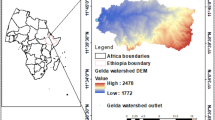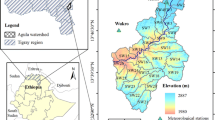Abstract
Watershed development and management plans are more important for harnessing surface water and groundwater resources in arid and semi-arid regions. To prepare a comprehensive watershed development plan, it becomes necessary to understand the topography, erosion status and drainage patterns of the region. This study was undertaken to determine the drainage characteristics of Pageru River basin using topographical maps on a scale of 1:50,000. The total area of the Pageru River basin is 480 km2. It was divided into X sub-basins for analysis. The drainage patterns of the basin are dendritic and include a sixth order stream. The quantitative analysis of various aspects of a river basin drainage network characteristics reveals complex morphometric attributes. The streams of lower orders mostly dominate the basin. The development of stream segments in the basin area is more or less affected by rainfall. The elongated shape of the basin is mainly due to the guiding effect of thrusting and faulting. The erosional processes of fluvial origin have been predominately influenced by the subsurface lithology of the basin.





Similar content being viewed by others
References
Cannon JP (1976) Generation of explicit parameters for a quantitative geomorphic study of the Mill Creek Drainage Basin. Oklahoma Geology notes 36(1):13–17
Chow Ven T (1964) (ed) Handbook of applied hydrology. McGraw Hill Inc, New York
Dornkamp JC, King CAM (1971) Numerical analyses in geomorphology, an introduction. St. Martins Press, New York, 372 pp
Gardiner V (1975) Drainage basin morphometry. British Geom Group, Tech Bull 14, 48 pp
Gregory KJ, Walling DE (1973) Drainage basin form and process a geomorphological approach. Arnold, London
Horton RE (1932) Drainage basin characteristics. Trans Am Geophys Union 13:350–361
Horton RE (1945) Erosional development of streams and their drainage basins; hydrophysical approach to quantitative morphology. Geol Soc Am Bull 56:275–370
Leopold LB, Miller JP (1956) Ephemeral streams: hydraulic factors and their relation to the drainage net. U.S. Geol Surv Profess, 282-A
Melton MA (1958) Geometric properties of mature drainage system and their representation in an E4 phase space. J Geol 66:35–54
Miller VC (1953) A quantitative geomorphic study of drainage basin characteristics in Clinch Mountain Area, Virginia and Tennessee. Technical report, 3, Office of the Naval Research. Dept. of Geology, Columbia Univ., New York
Schumm SA (1956) Evolution of drainage systems and slopes in Badlands at Perth Amboy, New Jersey. Natl Geol Soc Am Bull 67:597–646
Schumm SA (1963) Sinuosity of alluvial rivers on the great plains. Geol Soc Am Bull 74:1089–1100
Smith KG (1950) Standards for grading texture of erosional topography. Am J Sci 248:655–668
Smith KG (1958) Erosional processes and landforms in Badlands national monument South Dakota. Bull Geol Soc 69:975–1008
Sreedevi PD (1999) Assessment and management of groundwater resources of Pageru River basin, Cuddapah district, Andhra Pradesh, India. Unpublished Ph.D. Thesis, Sri Venkateswara Univ., Tirupati
Sreedevi PD, Srinivasulu S, Kesava Raju K (2001) Hydrogeomorphological and groundwater prospects of the Pageru River basin by using remote sensing data. Environ Geol 40(8):1088–1094
Strahler AN (1952) Hypsometric (area-altitude) analysis of erosional topography. Bull Geol Soc Am 63:1117–1142
Strahler AN (1964) Quantitative geomorphology of drainage basin and channel networks. In: Chow VT (ed) Handbook of applied hydrology. McGraw Hill Book Co., New York, pp 4–76
Sudheer AS (1986) Hydrogeology of the Upper Araniar River basin, Chittor district, Andhra Predesh, India. Unpublished Ph.D. Thesis, Sri Venkateswara Univ., Tirupati
Wentworth CK (1930) A simplified method of determining the average slope of land surfaces. Am J Sci 20:184–194
Acknowledgements
The authors wish to thank the Director NGRI for having given permission to publish the paper. The first author gratefully acknowledges the Council of Scientific and Industrial Research (CSIR) New Delhi, for financial assistance in the form of a Research Associate grant.
Author information
Authors and Affiliations
Corresponding author
Rights and permissions
About this article
Cite this article
Sreedevi, P.D., Subrahmanyam, K. & Ahmed, S. The significance of morphometric analysis for obtaining groundwater potential zones in a structurally controlled terrain. Env Geol 47, 412–420 (2005). https://doi.org/10.1007/s00254-004-1166-1
Received:
Accepted:
Published:
Issue Date:
DOI: https://doi.org/10.1007/s00254-004-1166-1




